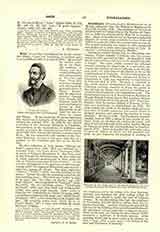

Guadalajara (GUADALAXARA), Archdiocese of, in Mexico, separated from the Diocese of Michoacan by Paul III, July 31, 1548. The residence of the bishop was first fixed at Compostela, in the Province of Tepic, but in 1560 was transferred by Pius IV to Guadalajara. Since its foundation the see has had a cathedral chapter, of twenty-seven members between 1830 and 1850, but at present (1908) they number only seventeen. The present cathedral was begun in 1571, completed and dedicated in 1618, and consecrated in 1716. It contains a celebrated painting by Murillo.
Among its notable bishops was the Dominican missionary, Felipe Galindo y Chavez, who was consecrated in 1695, and died in 1702. He founded in 1699 the diocesan seminary and gave it its constitution and a library. The same prelate exerted his influence towards securing the foundation of a university, entrusted the missions of Lower California to the Jesuits, and made two visitations of the diocese as far as the neighborhood of Coahuila. Nicolas Carlos Gomez de Cervantes, a canon of Mexico, consecrated Bishop of Guatemala in 1723, was transferred to Guadalajara in 1725 and died in 1734. He made a visitation of the whole diocese, strengthened the Jesuits in the California missions, founded in Texas the parish of San Antonio de Bexar, and assisted in building convents for the Dominican and Augustinian nuns. The Franciscan Francisco de S. Buenaventura Martinez de Texada Diez de Velasco was at first Auxiliary Bishop of Cuba and built the parish church of St. Augustine, Florida; later he became Bishop of Yucatan (1745), and was transferred to Guadalajara in. 1752. He twice visited the whole of his diocese, made generous donations of church ornaments and sacred vessels to indigent parishes, and aided in the erection of many churches. He died in 1760. The Dominican Antonio Alcalde, born in 1701, a lector in arts, master of students, lector in theology for twenty-six years, and prior of several convents of his order, became Bishop of Yucatan in 1763, and was transferred to Guadalajara in 1771. There he founded the university and a hospital (S. Miguel de Belem) for five hundred sick poor; he also improved the standard of teaching in the seminary and in the college of S. Juan Bautista, founded and endowed the girls’ college called El Beaterio, and placed it under the care of religious women. It was this bishop who built the sanctuary of Guadalupe, and left funds to defray there the expenses of worship. Another very large bequest left by him was for the building of the cathedral parish church. He introduced various industries to improve the condition of the poor, and during the great famine (1786) supported a multitude of destitute persons. After spending $1,097,000 on good works in his diocese, he died, August 7, 1793, a poor man—”the father of the poor and benefactor of learning”.
Juan Cruz Ruiz de Cabanas, rector of the seminary of Burgos (Spain), became Bishop of Nicaragua in 1794, and of Guadalajara in 1796. He gave new constitutions to the seminary and founded there new classes, also the clerical college and the hospice for the poor, established moral conferences for the clergy, fostered agriculture and the fine arts, and was instrumental in popularizing the practice of vaccination. It was he who crowned Iturbide emperor in 1824.
Pedro Espinosa, born in 1793, was rector of the seminary and of the university, and a dignitary of the cathedral, became Bishop of Guadalajara in 1854, and archbishop in 1863. He was persecuted on account of his vigorous defense of the rights of the Church, being banished for that reason by the Liberal Government. He placed the charitable institutions under the care of the Sisters of Charity. Pedro Loza, Bishop of Sonora in 1852, became Archbishop of Guadalajara in 1868, assisted at the Council of the Vatican, and died in 1898. He was the initiator of the system of free parochial primary schools; he improved the seminary to a remarkable degree, gave it its present building, ordained 536 priests, and built the churches of Nuestra Senora de los Dolores and San Jose.
The population of the diocese is about 1,200,000; it contains 83 parishes, 5 of which are in the episcopal city. The once numerous convents of Franciscans, Dominicans, Mercedarians, Augustinians, Carmelites, and Oratorians were suppressed by the Liberals; the Government, assuming the rights of ownership of the conventual buildings, converted most of them into bar-racks and afterwards alienated the remainder. Some of the Franciscan, Augustinian, and Mercedarian religious remained as chaplains of the churches that had been their own. In the ancient convent building of the Friars Minor at Zapopan there is a college for young men under the direction of Franciscans. The Jesuits, expelled by Charles III of Spain (1767), did not return until 1906, when they founded a college in the city of Guadalajara. The Religious of the Sacred Heart have for some years carried on a girls’ school. The seminary, having, in consequence of Liberal legislation, lost its own building, acquired the old convent of Santa Monica, which Archbishop Loza began to rebuild in 1891. Besides many other illustrious ecclesiastics, no fewer than thirty-one bishops have been trained in this establishment, which has now (1908) 1000 students. In the cities of Zapotlan and San Juan de los Lagos there are auxiliary seminaries. Free primary instruction is established in all the parishes of the archdiocese. At Guadalajara there is a female normal school under ecclesiastical supervision, also several hospitals and orphan asylums supported by charity. The hospital and endowments of S. Miguel de Belen and the hospice for the poor, foundations of former bishops, were seized by the Liberals.
DANIEL R. LOWEREE

